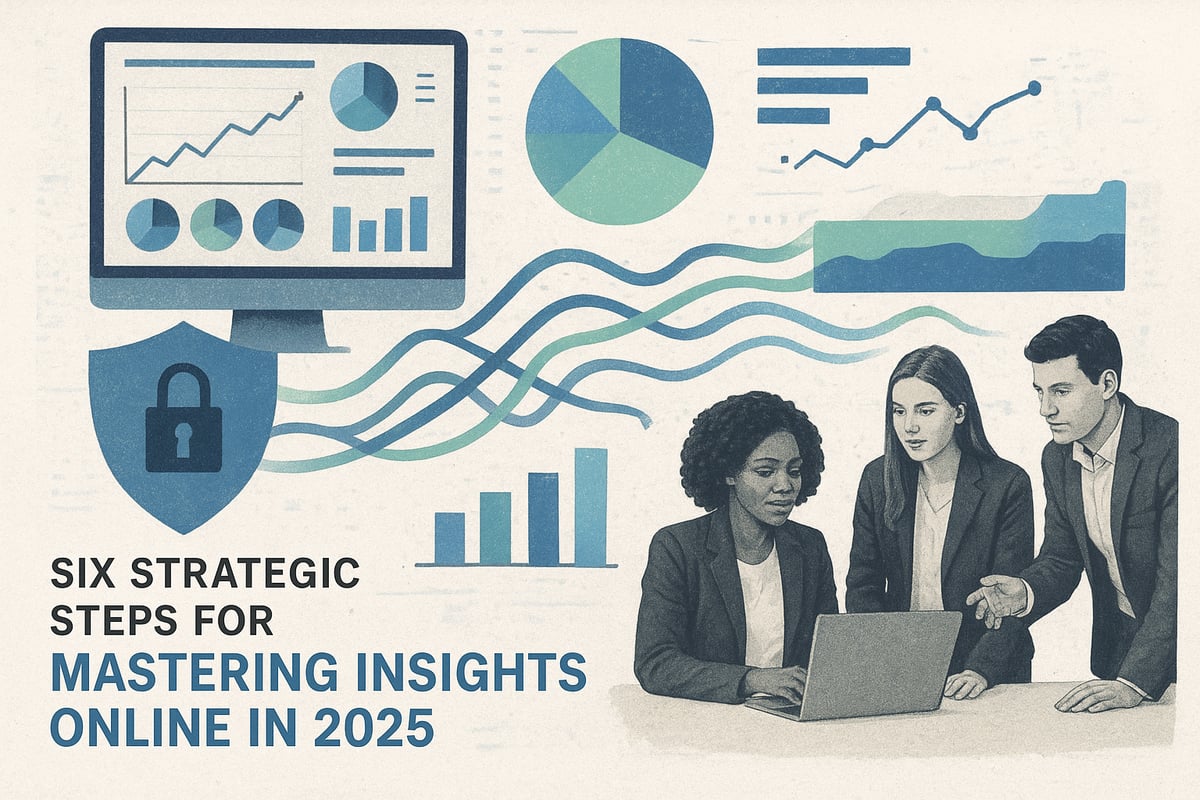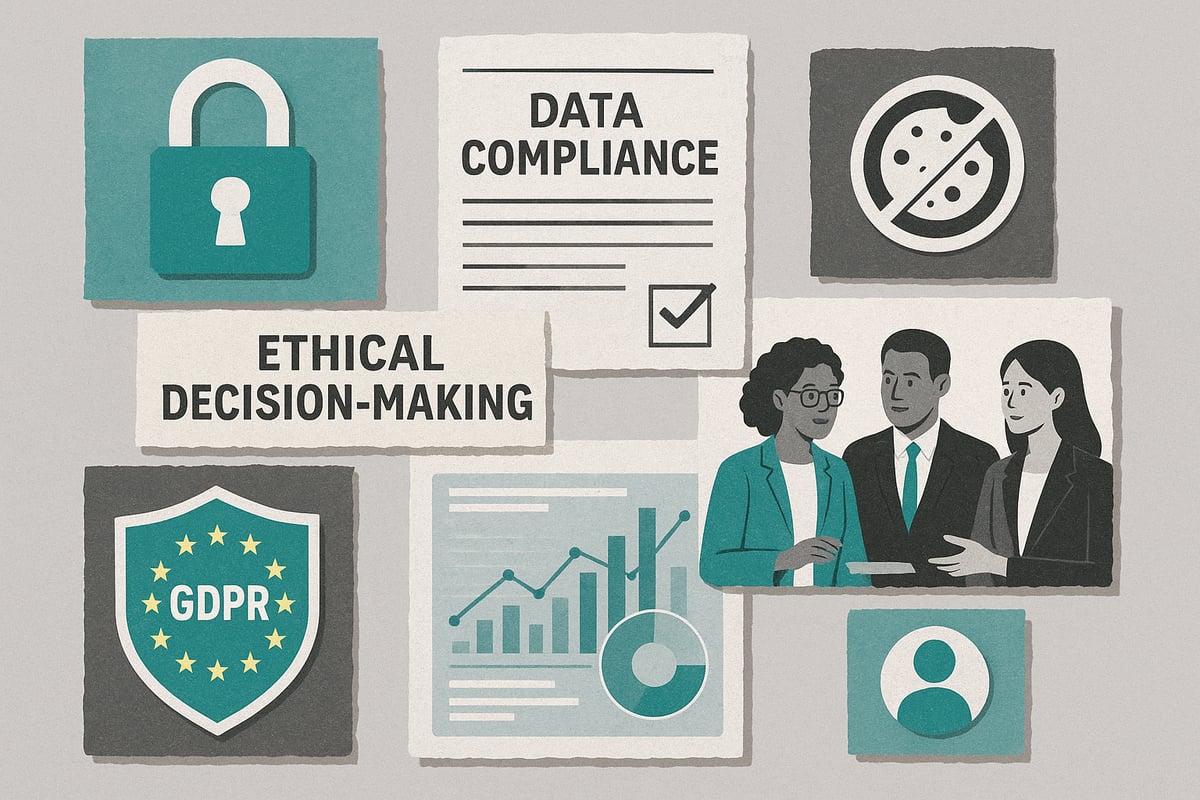- Date
The Ultimate Guide to Insights Online in 2025
 Andrii Romasiun
Andrii Romasiun
In 2025, the race to stay ahead in business is shaped by how well organizations harness insights online. Those who master digital intelligence are not just keeping pace—they are setting the standard for innovation and growth.
This guide is your essential resource for understanding, leveraging, and mastering insights online to drive smarter, data-driven decisions. We will cover the latest strategies, tools, and best practices for collecting, analyzing, and acting on actionable data.
You will discover what online insights truly mean, why they are more crucial than ever, and how evolving technologies are redefining success. From privacy trends to future predictions, this article will help you turn raw data into a competitive advantage for your business.
Understanding Online Insights in 2025
In 2025, the world of insights online has rapidly transformed, becoming the backbone of strategic decision-making for businesses of all sizes. Today, organizations must go beyond simply gathering data—they need to extract actionable meaning from the endless digital signals that customers leave behind. From marketing to product development, mastering insights online is now a critical competitive edge.

Defining Online Insights
Insights online in 2025 represent the actionable understanding gained from digital interactions, behaviors, and feedback across web, mobile, and connected platforms. Unlike raw data, which is simply unprocessed facts, or analytics, which describes patterns and trends, online insights focus on the “why” behind user actions.
For example, a retailer might use insights online to personalize shopping experiences, predicting what a customer wants before they search. This distinction is crucial across industries, from marketing to customer experience, as actionable insights fuel better decisions.
To clarify these differences further, the Analytics and Insight Explained guide provides a detailed exploration of how insights online stand apart from basic analytics. Ultimately, organizations that transform data into actionable insights online gain a true competitive advantage.
The Evolution of Insights: 2020-2025
Over the past five years, insights online have evolved from simple web analytics to a sophisticated, multidimensional understanding of users. Businesses no longer settle for counting clicks—they integrate behavioral economics and consumer psychology, building a fuller picture of motivation.
Advanced platforms now combine real-time analytics with predictive modeling, letting companies anticipate needs and trends. This evolution is evident in how leading businesses use insights online: according to Microsoft (2021), organizations leveraging advanced insights online outperform peers in sales growth by 85 percent.
The shift toward holistic insights online has redefined competitive benchmarks. Companies that act on these insights online can adapt faster, innovate more effectively, and meet customer expectations with precision.
Types of Insights: Quantitative vs. Qualitative
When discussing insights online, two main types emerge: quantitative and qualitative. Quantitative insights are based on numbers and metrics—like page views or conversion rates—while qualitative insights stem from user feedback, reviews, or sentiment.
| Type | Example Data | Use Case |
|---|---|---|
| Quantitative | Click-through rate | Measuring campaign effectiveness |
| Qualitative | User comments | Understanding customer sentiment |
For instance, combining survey responses with website behavior creates a richer picture. Hybrid strategies that blend both types of insights online enable businesses to understand not just what users do, but why they do it, leading to more robust strategies.
Key Metrics and KPIs for 2025
To succeed with insights online, focusing on the right metrics is essential. In 2025, business leaders track not only user engagement, conversion rates, and customer lifetime value, but also emerging KPIs like customer sentiment, predictive churn, and privacy compliance rates.
- User engagement
- Conversion rates
- Lifetime value
- Customer sentiment
- Predictive churn
- Privacy compliance rates
Notably, 74 percent of marketers express doubts about the reliability of their audience data (Nielsen). Prioritizing the most relevant KPIs ensures that insights online are actionable and drive meaningful outcomes.
The Business Impact of Actionable Insights
Actionable insights online reshape how companies innovate, market, and serve customers. For example, 83 percent of businesses prioritize customer experience, yet most still struggle to deliver (Salesforce, 2021).
Organizations that consistently leverage insights online outperform competitors in growth and profitability. By embedding insights online in every department, companies unlock new opportunities and elevate the entire customer journey.
The Modern Insights Ecosystem: Tools, Technologies & Platforms
The landscape for insights online in 2025 is more dynamic, privacy-focused, and technologically advanced than ever. Businesses must navigate a complex ecosystem of platforms and tools to turn vast data streams into actionable intelligence. Understanding the latest technologies and knowing how to integrate them is essential for staying competitive.
Core Technologies Powering Insights Online
At the heart of insights online in 2025 are advanced technologies that collect, process, and interpret data at scale. Artificial intelligence and machine learning automate pattern detection and predictive analytics, enabling real-time decision-making. Big data platforms process enormous volumes of structured and unstructured information, while automation tools streamline data collection and reporting.
Cloud-based analytics solutions provide flexibility and scalability, allowing businesses to access insights online from anywhere. APIs and integrations are now standard, enabling seamless connection between web, mobile, CRM, and offline sources. For example, predictive analytics tools use historical sales data to forecast future trends, helping teams adapt strategies quickly.
These technologies collectively empower organizations to respond to market changes using insights online, transforming raw data into competitive business value. The result is a more agile, informed, and responsive organization.
Leading Insights Platforms in 2025
Selecting the right platform for insights online is crucial. Leading solutions such as Google Analytics, Mixpanel, and Amplitude offer robust dashboards, granular segmentation, real-time tracking, and error monitoring. Emerging privacy-focused tools are also gaining market share, offering features like cookieless analytics and enhanced data control.
| Platform | Key Features | Privacy Focus |
|---|---|---|
| Google Analytics | Real-time, dashboards, segmentation | Moderate |
| Mixpanel | Event tracking, cohort analysis | Moderate |
| Amplitude | Product analytics, funnels | Moderate |
| Privacy-first Tools | Cookieless, GDPR, data ownership | High |
Top brands evaluate platforms based on scalability, privacy, and integration capabilities. For best practices on leveraging site insights, see this Site Insights Best Practices guide, which complements the strategies discussed here.
Choosing the right platform helps organizations translate insights online into targeted campaigns and product improvements.
Privacy-First Analytics: The Rise of Cookieless Solutions
As privacy regulations tighten, privacy-first analytics are reshaping insights online. Businesses are moving away from third-party cookies and intrusive tracking, focusing instead on solutions that prioritize user consent and data protection. GDPR and similar laws require organizations to adopt ethical approaches.
Privacy-focused platforms now offer cookieless tracking, advanced anonymization, and compliance monitoring. These tools help businesses maintain customer trust while extracting valuable insights online. For example, companies that adopt privacy-first analytics avoid intrusive cookie banners and demonstrate a clear commitment to user rights.
This shift is essential for future-proofing strategies and ensuring insights online remain both actionable and compliant in a rapidly evolving digital world.
Integrating Multiple Data Sources for Holistic Insights
Achieving a unified view of customer behavior requires integrating multiple sources for insights online. Businesses combine web, mobile, CRM, and offline data to build a 360-degree customer profile. However, this process is not without challenges, including data silos, inconsistent identifiers, and interoperability issues.
Omnichannel attribution is a prime example: A retail brand might track a customer's journey from a mobile ad to an in-store purchase, connecting the dots across platforms. API-driven integrations and identity resolution tools are essential for overcoming data fragmentation.
Unified data enables organizations to generate richer, more accurate insights online, supporting better decision-making and personalized engagement across all touchpoints.
Swetrix: Privacy-Focused Analytics for Actionable Insights
Swetrix stands out in the insights online ecosystem as a privacy-focused, open-source analytics platform. It offers cookieless tracking, GDPR compliance, customizable dashboards, error monitoring, and real-time alerts. Swetrix empowers organizations to collect and analyze insights online without compromising user privacy or requiring disruptive cookie banners.

For example, an EU-based business may need full data ownership and ethical analytics to comply with strict regulations. Swetrix provides a transparent, secure solution that addresses these needs while delivering actionable insights online.
Organizations that prioritize privacy, compliance, and actionable intelligence will find Swetrix an ideal choice for thriving in 2025 and beyond.
Step-by-Step: Building an Effective Online Insights Strategy in 2025
Building a successful strategy for insights online in 2025 requires a clear, systematic approach. As digital ecosystems grow more complex, following a structured process ensures you collect, analyze, and act on the right data. This step-by-step guide offers a roadmap for organizations that want to transform raw data into business growth by leveraging insights online.

Step 1: Setting Clear Objectives and KPIs
The foundation of any insights online strategy is defining what success looks like. Start by aligning your insights online goals with overall business objectives. Whether your focus is on increasing customer retention, accelerating product innovation, or improving marketing ROI, clarity is essential.
Identify specific KPIs for each department. For example, marketing teams may prioritize conversion rates, while product teams track feature adoption. Use a table to compare KPIs across functions:
| Department | Example KPI | Description |
|---|---|---|
| Marketing | Conversion Rate | % of visitors taking action |
| Product | Feature Adoption | % of users using new features |
| CX | Customer Satisfaction | NPS or satisfaction scores |
For more granular guidance, review the Guide to Website Insights, which offers actionable steps for setting measurable objectives tailored to your digital environment.
Step 2: Selecting the Right Tools and Platforms
Choosing the right technology stack is critical for actionable insights online. Evaluate analytics and insight platforms based on several criteria:
- Depth and granularity of data
- Ease of use for both technical and non-technical users
- Privacy compliance and data security
- Integration capabilities with existing tools
Balanced evaluation helps you select between traditional analytics platforms and privacy-first solutions. For instance, marketing teams may prefer user-friendly dashboards, while IT may emphasize robust data integration. Always ensure your chosen platform supports your KPIs and compliance needs.
Step 3: Data Collection and Integration
Effective insights online strategies rely on comprehensive, high-quality data. Collect both quantitative data (web analytics, transaction logs) and qualitative feedback (surveys, user interviews). Integrate data sources from web, mobile, CRM, and social platforms for a holistic view.
APIs are invaluable for seamless data flow across systems. For example, integrating website analytics with CRM data enables advanced segmentation. Overcoming data silos and ensuring interoperability are crucial for unified, actionable insights online.
Step 4: Ensuring Data Quality and Compliance
High-quality data is the lifeblood of insights online. Validate data for accuracy and consistency before analysis. Address common challenges like incomplete records, identity resolution, and outdated information.
Compliance with regulations such as GDPR is non-negotiable. Regular audits and privacy checks ensure your strategy remains ethical and legal. Remember, according to Nielsen, 36% of marketers struggle to extract value from insights online due to data access issues. Investing in data governance pays dividends in trust and performance.
Step 5: Analyzing and Interpreting Data
Turning raw data into insights online requires robust analytical techniques. Use segmentation to identify distinct user groups, cohort analysis to track behavior over time, and trend detection to spot emerging opportunities.
AI and machine learning can enhance your analysis, enabling predictive modeling and anomaly detection. For example, machine learning algorithms can forecast customer churn, allowing proactive retention strategies. Interpreting findings accurately is essential for generating relevant, actionable insights online.
Step 6: Turning Insights into Action
The final step is translating insights online into business impact. Collaborate across departments—marketing, product, and customer experience—to implement data-driven strategies. Personalize user journeys, optimize campaigns, and inform product roadmaps using your findings.
Action is where value materializes. Organizations that turn insights online into concrete initiatives consistently outperform their peers in growth and profitability. Keep iterating, measuring, and refining your approach for sustained competitive advantage.
Privacy, Ethics, and Compliance in Online Insights
The landscape for insights online is rapidly evolving, shaped by stricter privacy laws, ethical demands, and compliance challenges. In 2025, organizations must navigate these factors to unlock value from data while building trust with users.

The Evolving Privacy Landscape in 2025
In 2025, privacy regulations define the boundaries for insights online. Laws such as GDPR and CCPA set global standards for data collection, usage, and transparency. Newer regulations are emerging in Asia and Latin America, further complicating compliance for international businesses.
Consumers now expect clarity on how their data fuels insights online. They demand transparent communication and control over their personal information. As a result, many organizations are moving away from intrusive tracking. For example, avoiding cookie banners and using privacy-first analytics solutions has become a competitive necessity.
Ethical Considerations in Data Collection and Analysis
Ethics take center stage in the pursuit of insights online. Businesses must balance their drive for actionable intelligence with respect for individual privacy. Collecting only necessary data, securing consent, and anonymizing information are now best practices.
Bias and discrimination are real risks when using insights online to inform automated decisions. Ethical frameworks help organizations design fair algorithms and avoid reinforcing stereotypes. For instance, using anonymized datasets ensures user privacy while reducing the risk of unfair targeting or exclusion.
GDPR and Cookieless Analytics: What Businesses Need to Know
The General Data Protection Regulation (GDPR) remains the gold standard for compliance in insights online. Key requirements include obtaining explicit consent, providing data access, and enabling users to request deletion. In 2025, the shift toward cookieless analytics is accelerating, driven by the need to protect user privacy and simplify compliance.
Platforms that offer 100% cookieless tracking are becoming popular among organizations seeking robust insights online without legal headaches. These solutions eliminate the need for cookie banners and reduce the risk of non-compliance. For a deeper dive into privacy-first analytics, see Privacy-Friendly Analytics, which explores how ethical data collection supports compliance and user trust.
Building Trust Through Transparent Insights Practices
Trust is the foundation of effective insights online strategies. Organizations must be transparent about their data practices, using plain language and accessible privacy policies. Communicating how data is collected, analyzed, and protected reassures users and sets businesses apart from less transparent competitors.
Leading companies now treat privacy-first approaches as a core brand differentiator. By prioritizing ethical data use, they foster loyalty and encourage customers to participate in feedback and data-sharing, ultimately making insights online more valuable.
Future-Proofing Insights Strategies for Compliance
Regulations will continue to evolve, making adaptability essential for anyone relying on insights online. Businesses should invest in analytics solutions that are flexible and privacy-ready. Preparing for new laws and emerging technologies now will minimize future disruption.
Ultimately, compliance in insights online is more than a legal requirement—it is a business imperative. Forward-thinking organizations prioritize privacy and ethics to ensure long-term growth and resilience.
The Future of Online Insights: Trends and Predictions for 2025 and Beyond
The future of insights online is unfolding rapidly as new technologies, methodologies, and ethical considerations transform how organizations gather and act on data. In 2025, businesses must adapt to a landscape where automation, privacy, and user empowerment shape every aspect of insights online. Let us explore the five trends you cannot afford to ignore.
AI and Automation in Insights Generation
AI is redefining how organizations approach insights online. Advanced machine learning models now automate data collection, pattern recognition, and even the delivery of personalized recommendations. Predictive and prescriptive analytics are no longer futuristic concepts—they are standard practice for leading businesses.
Tools powered by AI offer real-time anomaly detection, flagging outliers before they impact operations. Automation streamlines reporting and visualization, allowing decision-makers to focus on strategy rather than manual analysis. As outlined in AI-Powered Analytics Trends for 2025, companies leveraging these technologies see faster, more accurate business decisions. The result is a competitive edge for those who invest in intelligent insights online.
The Rise of Zero-Party and First-Party Data
As privacy regulations tighten, organizations are moving away from third-party data and embracing zero-party and first-party data for insights online. Zero-party data is information users proactively share, such as preferences or intentions, while first-party data comes from direct interactions with your brand.
Collecting these types of data requires new strategies. Interactive content, feedback forms, and loyalty programs are effective tools. Brands that master this shift can build trust, improve personalization, and remain compliant. By prioritizing direct data relationships, businesses ensure their insights online are both ethical and future-proof.
Hyper-Personalization and Experience Optimization
Hyper-personalization is becoming the gold standard for digital experiences. Using insights online, organizations tailor content, offers, and messaging to individual users in real time. AI-driven segmentation and dynamic content delivery enable companies to adapt to user behavior instantly.
For example, a retailer might modify its homepage based on browsing history or send targeted notifications triggered by in-session behavior. This level of personalization leads to higher engagement, increased loyalty, and improved conversions. Companies that invest in experience optimization through insights online will stand out in a crowded marketplace.
Democratization of Insights: Empowering Non-Technical Teams
The democratization of insights online is breaking down barriers across organizations. No-code and low-code analytics platforms empower marketing, product, and customer experience teams to run their own analyses without heavy reliance on data scientists.
This shift accelerates decision-making and fosters a data-driven culture. As highlighted in Ten Trends in Research, Insights & Analytics for 2025, tools that bring insights online to non-technical users are critical for agility and innovation. When everyone can access and act on data, businesses unlock new levels of creativity and responsiveness.
The Growing Importance of Ethical AI and Responsible Data Use
As AI takes center stage in insights online, ethical considerations become paramount. Responsible data use requires transparency, fairness, and accountability at every step. Businesses must audit algorithms for bias, anonymize sensitive information, and communicate data practices clearly.
Ethical AI is not just a regulatory requirement—it is a foundation for long-term trust. Organizations that prioritize responsible insights online will attract loyal customers and avoid reputational risk. In a future shaped by rapid technological change, ethics and compliance are essential pillars of sustainable growth.
As we’ve explored, mastering online insights in 2025 means more than just collecting data—it’s about turning privacy-first analytics into real business advantages. If you’re ready to gain a clearer view of your website’s performance while respecting your users’ privacy, it’s time to take action. Swetrix gives you intuitive, GDPR-compliant analytics without the hassle of cookie banners, so you can focus on what matters: actionable insights and ethical growth. You deserve analytics that work for you and your audience—no compromises required.
Check out Swetrix today